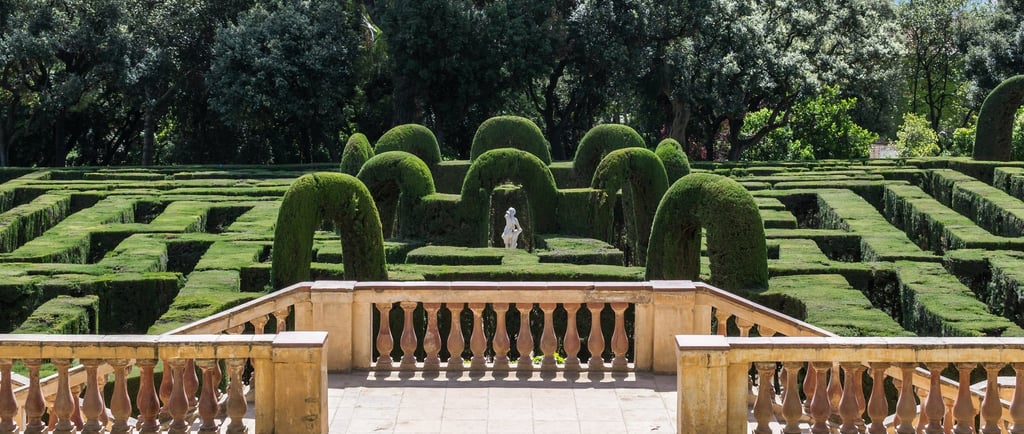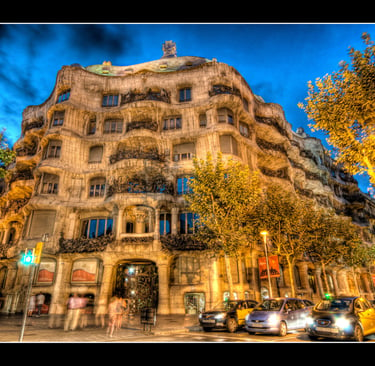Barcelona – Gaudí’s Labyrinth
Wander through Barcelona, where Gaudí’s surreal architecture weaves a vibrant maze of color, culture, and Catalan spirit.
DESTINATIONS
Jetsclusive
6/29/20255 min read


Barcelona – Gaudí’s Labyrinth
Barcelona invites you to get lost in its beauty. The city bursts with art and architecture, combining bright colors with bold forms at every turn. Here, labyrinths aren’t only found in gardens—they live in stone, tile and even the city’s spirit. Both the tranquil Horta Labyrinth and Antoni Gaudí’s creations challenge visitors to wander, wonder and see the world through new eyes.
Let’s follow the winding paths—both leafy and architectural—that turn Barcelona into a city of endless discovery.
Discovering the Labyrinth of Horta: Barcelona’s Green Gem
Tucked away from the city’s busy heart, the Parc del Laberint d’Horta stands as Barcelona’s oldest conserved garden. Think of it as a green secret: a perfect spot to pause, recharge and lose yourself (on purpose).
The Horta Labyrinth holds more than hedges. It features an elegant mix of neoclassical symmetry, mythological sculpture, romantic corners and quiet ponds that invite reflection. It’s where art, nature and the magic of getting a little lost meet.
The History and Design of Horta Labyrinth
The story of this maze began in 1791 when Joan Antoni Desvalls, sixth Marquess of Llupià, wanted a garden retreat for his estate. With help from Italian architect Domenico Bagutti and French gardener Delvalet, he planned a neoclassical layout, later enhanced with romantic touches.
Originally a private playground for aristocrats, the estate opened to the public in the late 20th century. Over the years, it gained new romantic gardens, bridges and fountains, while keeping its original maze and classical lines. The beautiful Desvalls manor, with its Moorish-inspired details, marks the grand entrance—hinting at the surprises inside.
The Mythological and Romantic Elements
The park isn’t only about plants. It’s an open-air gallery with stories in marble and stone. Most famous is the small Eros statue at the maze center—a playful nod to love and confusion.
Scattered through the park, you’ll find reliefs of Greek myths, statues of nymphs, muses and more. Water channels, springs and ponds add a softer note, reflecting the trees and sky. The romantic garden, added in the 1800s, brings winding paths, shaded glades, and clusters of sweet-smelling flowers. Together, these elements create a setting where fantasy meets real life.
Visitor Experience: Navigating the Maze and Beyond
Those entering the Horta Labyrinth should expect more than a quick stroll. Here’s how to make the most out of your visit:
Arrive early or late in the day to avoid crowds, especially on weekends.
Get ready to wander (and maybe backtrack): the hedge maze delights in confusing you before revealing its heart.
Bring snacks or a picnic for the shady benches. The park allows you to slow down and enjoy.
Look for the details in statuary, fountains, and bridges—you’ll find something surprising in every corner.
Romantic Garden and Desvalls Mansion: Spend time in the more natural areas and don’t miss the grand entry, with its Moorish flourishes and sweeping staircase.
Accessibility: Main paths are well-kept, though some garden sections and the historic house may be less friendly for wheelchairs or strollers. Comfortable shoes help.
The Laberint d’Horta park offers a gentle, poetic start to the city’s theme of mazes—where each path can turn into a new discovery.
Gaudí’s Barcelona: A Labyrinth of Architectural Wonders
While the Horta maze is green, Gaudí’s ‘labyrinth’ covers urban space—twisting and turning through color, curve and creativity. His works ripple across Barcelona, challenging visitors to see buildings as works of art. Wandering between them feels like exploring a maze built not of leaves but of imagination.
Gaudí’s masterpieces form a journey where each facade leads to deeper layers of symbolism, technique, and Catalan identity.
Compare Private Jet Pricing To Barcelona Here Powered By Villers Jets - Trusted by 1000+ worldwide
Gaudí’s Signature Style and Techniques
Antoni Gaudí took inspiration from nature at every step:
Flowing lines: No harsh squares or angles—everything bends and moves, as if shaped by wind and water.
Organic motifs: Swirling iron gates, tiled lizard sculptures, and mushroom-like chimneys.
Innovative structures: He experimented with ruled geometry, parabolic arches, and leaning columns.
Colorful mosaics: Trencadís, a mosaic style using broken tiles, lights up places like Park Güell.
Light play: Stained glass and shifting shadows turn interiors into kaleidoscopes.
The best examples? The towering spires and tree-like columns at Sagrada Família, the playful architecture of Park Güell, and surreal homes like Casa Batlló and La Pedrera (Casa Milà).
Navigating Gaudí’s ‘Labyrinth’ of Masterpieces
For many, discovering Gaudí’s buildings is like tracing a winding path through a hidden garden. Don’t miss these key stops:
Sagrada Família: The city’s most iconic church, still under construction, with fantastically detailed facades and stained glass interiors. Book tickets weeks in advance and pick an early morning slot for fewer crowds.
Park Güell: A mosaic-filled park with sweeping city views, winding paths, whimsical benches, and the iconic mosaic lizard. The park has both free and ticketed areas—aim for early tickets online.
Casa Batlló: This “dragon house” on Passeig de Gràcia shines with undulating lines and colorful tiles. Go at sunset if you can for the light shows.
La Pedrera (Casa Milà): Waves of stone on the exterior, plus a roof full of twisting, sculpture-like chimneys.
Casa Vicens: Gaudí’s first important home, offering a glimpse of his early ideas
Walk between these sites to get a sense of Barcelona’s unique rhythm—each step brings a fresh perspective.
Tips for an Architectural Tour:
Book ahead, especially for Sagrada Família, Park Güell, and Casa Batlló.
Download city walking tour apps or join a guided walk for deeper stories.
Look up: Gaudí’s details are hidden on rooftops, doorways, and balconies.
Compare Private Jet Pricing To Barcelona Here Powered By Villiers Jets - Trusted by 1000+ worldwide
Gaudí’s Enduring Impact on Barcelona
Gaudí shaped Barcelona’s skyline, but his legacy goes deeper. His bold ideas and love for Catalonia’s culture helped fuel a sense of local identity. Today, his buildings are world-famous—some, like Sagrada Família, Park Güell, La Pedrera, and Casa Batlló, count as UNESCO World Heritage Sites.
Modern architects and designers look to Gaudí as proof that rules can bend. He helped turn Barcelona into one of Europe’s top travel destinations, drawing millions each year to explore not only buildings, but also the creativity and pride behind them.
Conclusion
Barcelona is a city built for wandering—sometimes on purpose, sometimes by mistake. The Horta Labyrinth hides in green silence, coaxing visitors to lose and find themselves among myth and romance. In Gaudí’s work, you’ll find another, even grander maze: buildings that surprise, confuse, and delight with every turn.
Both labyrinths invite you to pause, think, and look beyond the surface. Next time you visit Barcelona, step into these winding worlds. Let the city’s many paths show you its secrets, layer by layer.


Luxury
Explore the world of private aviation and travel.
support@jetsclusive.net
© 2025. All rights reserved.
